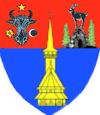- Baia Sprie
-
"Kisbánya" redirects here. For the commune sometimes known by this name in Hungarian, see Băiţa, Hunedoara.
Baia Sprie
Felsőbánya— Town — 
Coat of armsLocation of Baia Sprie
Coordinates: 47°39′39″N 23°41′19″E / 47.66083°N 23.68861°ECoordinates: 47°39′39″N 23°41′19″E / 47.66083°N 23.68861°E Country  Romania
RomaniaCounty Maramureş County Status Town Government – Mayor Vasile Dorin Pasca Area – Total 96 km2 (37.1 sq mi) Population (2002) – Total 16,609 Time zone EET (UTC+2) – Summer (DST) EEST (UTC+3) Website http://www.baiasprie.com/ Baia Sprie (Romanian pronunciation: [ˌbaja ˈspri.e] (
 listen); Hungarian: Felsőbánya, German: Mittelstadt) is a town in the Maramureş County, northern Romania. The Hungarian version of the town's name means "Upper Mine".
listen); Hungarian: Felsőbánya, German: Mittelstadt) is a town in the Maramureş County, northern Romania. The Hungarian version of the town's name means "Upper Mine".The town administers three villages: Chiuzbaia, Satu Nou de Sus and Tăuţii de Sus. Neighbouring communities are the city of Baia Mare and the villages of Groşi, Dumbrăviţa, Şiseşti and Deseşti. Of the town's total population, about 11,500 live in the town of Baia Sprie, with a Romanian majority and a Hungarian minority of about 28%.
The town was one of the most important mining centers in north-western Romania, exploitation of gold and silver being mentioned in documents written around 1411, the time when the Saxons colonized the region. However, recent administrative changes and restructuring of the Romanian mining industry brought this activity to an almost complete halt.
History
The first written mention of the settlement dates back to 1329 as "Civitas in medio monte". The town was in Szatmár County, in the Kingdom of Hungary. King Sigismund, Holy Roman Emperor, as part of treat with Serbian ruler Despotus Stefan Lazarević, gave him Baia Sprie as a gift, at 1411., until Depotus' death in 1426. A year after, lord of Baia Sprie became Stefan's successor Despotus Đurađ Branković of Serbia. In 1567, it was annexed by Prince János Zsigmond, prince of Transylvania. In 1605 - 1606, 1621 - 1629 and 1645 - 1648 the town and the county were part of the Principality of Transylvania.
In the 1910 census, the following languages were spoken in the township: Hungarian language 93.8%, Romanian language 5.2% and others 1.0%. At the same census the following religions were represented: Roman Catholic 52.1%, Greek Catholic 28.1%, Calvinist 13.3%, Judaism 6.1% and others 0.5%.
From the 1919 to 1940 the town was part of the Kingdom of Romania. Between 1940 and 1944 it was part of Hungary and since 1944 the town has been in Romania. The township belonged alternately to the Baia Mare Region (in 1952 – 1960), Maramureş Region (1960 – 1968) and, as of 1968, Maramureş County.
Population
The total population of the township was 16,609 in 2002, of which the main ethnic groups were 12,469 Romanians (75%), 3,441 Hungarians (21%) and 576 Roma (3.5%).
The main religious groups were 11,344 Romanian Orthodox, 2,739 Roman Catholic, 886 Calvinist and 636 Greek Catholic.
External links
- Photos of the town and its surroundings in the dedicated Flickr group
Cities Baia Mare (county seat) · Sighetu Marmației

Towns Baia Sprie · Borșa · Cavnic · Dragomirești · Săliștea de Sus · Seini · Șomcuta Mare · Târgu Lăpuș · Tăuții-Măgherăuș · Ulmeni · Vișeu de Sus
Communes Ardusat · Ariniş · Asuaju de Sus · Băiţa de sub Codru · Băiuţ · Bârsana · Băseşti · Bicaz · Bistra · Bocicoiu Mare · Bogdan Vodă · Boiu Mare · Botiza · Budeşti · Călineşti · Câmpulung la Tisa · Cerneşti · Cicârlău · Coaş · Coltău · Copalnic-Mănăştur · Coroieni · Cupşeni · Deseşti · Dumbrăviţa · Fărcaşa · Gârdani · Giuleşti · Groşi · Groşii Ţibleşului · Ieud · Lăpuş · Leordina · Mireşu Mare · Moisei · Oarţa de Jos · Ocna Şugatag · Onceşti · Petrova · Poienile de sub Munte · Poienile Izei · Recea · Remetea Chioarului · Remeţi · Repedea · Rona de Jos · Rona de Sus · Rozavlea · Ruscova · Săcălăşeni · Săcel · Sălsig · Săpânţa · Sarasău · Satulung · Şieu · Şişeşti · Strâmtura · Suciu de Sus · Vadu Izei · Valea Chioarului · Vima Mică · Vişeu de Jos
Categories:- Towns in Romania
- Populated places in Maramureș County
Wikimedia Foundation. 2010.
